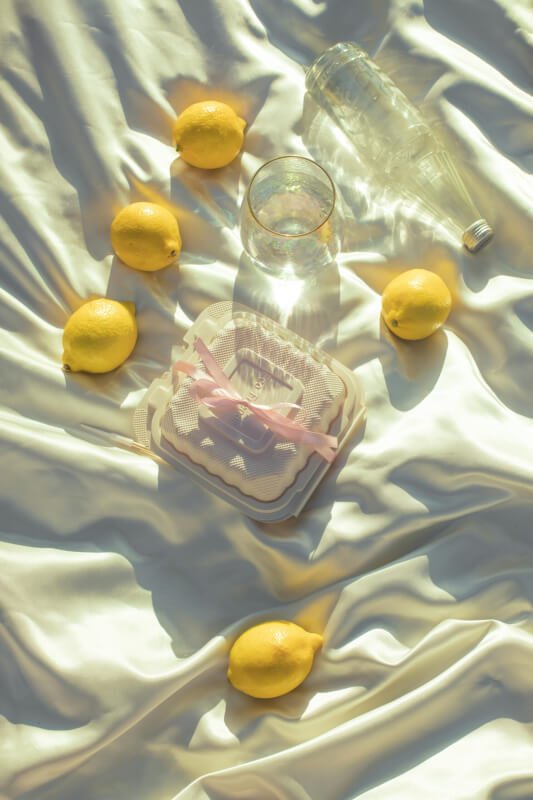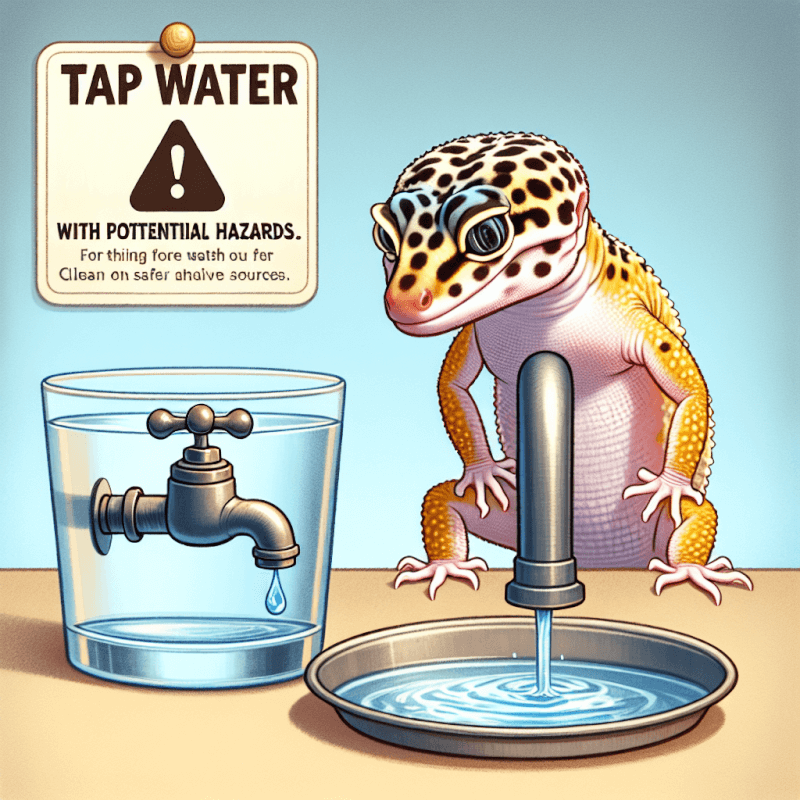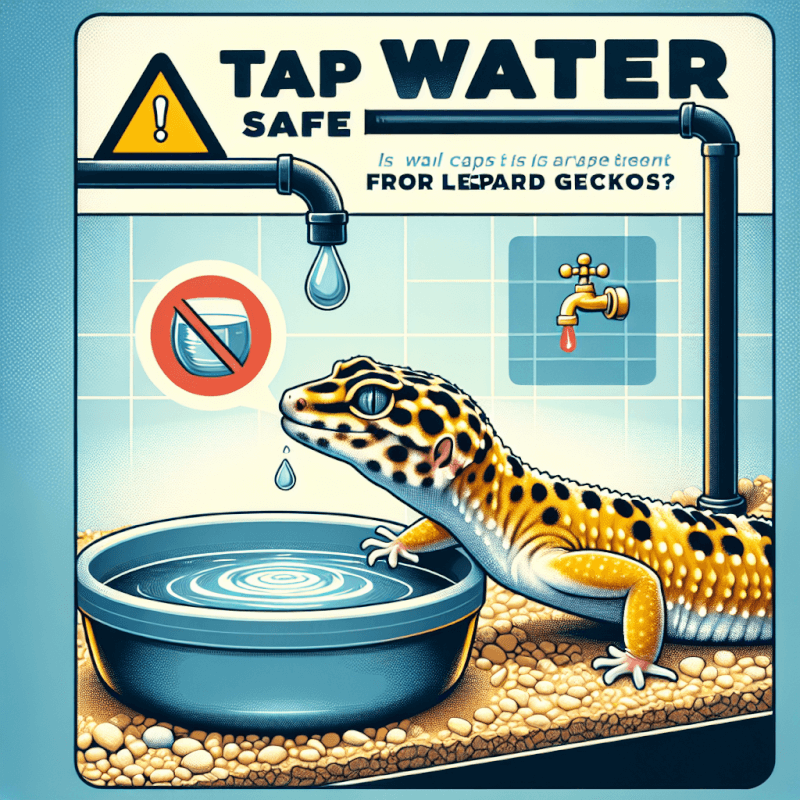Leopard geckos are fascinating creatures to have as pets, but when it comes to their hydration needs, it’s important to ensure they receive the right kind of water. While you might be tempted to simply offer them tap water, it’s crucial to understand the potential risks involved. In this article, you will discover why tap water may not be the best choice for your leopard gecko and learn about alternative options that prioritize their health and well-being.
The Importance of Water for Leopard Geckos
Leopard geckos, like all living creatures, require water as a vital nutrient for their survival. Water plays several crucial roles in their overall health and well-being, including digestion and hydration. As a responsible pet owner, understanding the significance of water for leopard geckos is essential in ensuring their optimal care and longevity.
Water as a Vital Nutrient
Water is necessary for leopard geckos as it is for any other living organism. It serves as a crucial nutrient that enables various essential bodily functions. Just like humans, leopard geckos rely on water to maintain proper physiological processes, including circulation, digestion, metabolism, and temperature regulation.
Without an adequate intake of water, leopard geckos can experience dehydration, which can lead to severe health issues or even death in severe cases. Therefore, providing clean and accessible water sources is of utmost importance for their overall well-being.

The Role of Water in Digestion and Hydration
Water plays a critical role in digestion for leopard geckos. It aids in the breakdown of food particles and the absorption of nutrients in their digestive system. Without enough water, their digestive processes can be compromised, leading to issues like constipation or impaction.
Hydration is another vital aspect of water for leopard geckos. These reptiles do not have the ability to sweat like humans, making it crucial for them to consume enough water to maintain proper hydration levels. Adequate hydration supports their overall health and physiological functions, including the health of their skin, organs, and overall vitality.
Understanding Tap Water
Tap water is the most easily accessible source of water for many households. However, before using it for your leopard gecko, it is essential to understand its composition and any potential risks associated with it.
Composition of Tap Water
Tap water typically contains a mixture of minerals, such as calcium, magnesium, and potassium, which are essential for the overall health of leopard geckos. These minerals contribute to various physiological functions, including muscle and nerve function, bone development, and blood clotting.
Tap water can also contain traces of contaminants or chemical additives, such as chlorine and chloramines, which are used to treat and disinfect water supplies. While these additives are necessary to ensure safe drinking water for humans, they can be harmful to leopard geckos if not properly addressed.
Chlorine and Chloramines in Tap Water
Chlorine and chloramines are commonly found in tap water due to their disinfecting properties. While they help control harmful bacteria and pathogens, these chemicals can be toxic to leopard geckos if ingested in high concentrations.
Chlorine readily evaporates if left to sit for a few hours, making tap water safe for consumption for leopard geckos after the chlorine has dissipated. However, chloramines do not dissipate as quickly, and proper steps must be taken to remove them before offering tap water to your gecko.

Potential Risks of Tap Water for Leopard Geckos
While tap water can be a convenient water source for leopard geckos, it also carries potential risks if not properly treated or filtered. It is crucial for pet owners to be aware of these risks to ensure the health and well-being of their geckos.
Chlorine and Chloramines Toxicity
Chlorine and chloramines, if consumed in high concentrations, can be toxic to leopard geckos. These chemicals can irritate their digestive systems, leading to discomfort, dehydration, or even severe illness. It is important to take the necessary steps to remove or neutralize these chemicals before offering tap water to your gecko.
Chemical Additives and Contaminants in Tap Water
Tap water may contain other chemical additives or contaminants that can be harmful to leopard geckos. These can include heavy metals, pesticides, and other pollutants that may be present in the water supply. While these contaminants are often within safe levels for human consumption, they may have adverse effects on the health of your leopard gecko. Therefore, it is vital to take precautions to ensure the water provided to your gecko is safe and free from any harmful substances.
Preparing Tap Water for Leopard Geckos
To make tap water safe and suitable for leopard geckos, certain measures need to be taken to remove or neutralize any potential toxins or contaminants. This involves dechlorinating the water, filtering it if necessary, and ensuring it reaches room temperature before offering it to your gecko.
Dechlorinating Tap Water
Dechlorinating tap water is an essential step in making it safe for leopard geckos. There are various methods available to accomplish this, such as using water conditioners specifically designed for reptiles or allowing the water to sit uncovered for several hours to allow the chlorine to dissipate naturally.
Water conditioners can quickly and effectively remove both chlorine and chloramines from tap water, ensuring it is safe for consumption by leopard geckos. It is essential to follow the instructions provided by the manufacturer when using water conditioners to ensure the correct dosage and adequate treatment of the water.
If you choose to let tap water sit uncovered to remove chlorine naturally, it is recommended to leave it uncovered for at least 24 hours. However, this method may not be as reliable as using a water conditioner, as it does not effectively remove chloramines.
Filtering Tap Water
Filtering tap water can help remove any potential contaminants or impurities that may be present. Using a quality water filter designed for reptile care can be an effective way to ensure the water provided to your leopard gecko is free from harmful substances.
When choosing a water filter, select one that is capable of removing chlorine, chloramines, heavy metals, and other impurities typically found in tap water. Regular maintenance and replacing the filter as recommended by the manufacturer are essential to ensure the water remains clean and safe for your gecko.
Allowing Tap Water to Reach Room Temperature
Before offering tap water to your leopard gecko, it is crucial to allow it to reach room temperature. Leopard geckos are ectothermic creatures, meaning their body temperature is regulated by their environment. Offering water that is too cold or too hot can disrupt their body temperature and potentially lead to stress or health issues.
Allowing tap water to sit at room temperature for a few hours before providing it to your gecko ensures that it will be at a suitable temperature for them to drink comfortably.

Alternative Water Sources for Leopard Geckos
While tap water can be made safe and suitable for leopard geckos, some pet owners prefer alternative water sources to minimize potential risks. Here are a few alternative options to consider:
Bottled Spring Water
Bottled spring water is a popular alternative to tap water for leopard geckos. It is typically free from chlorine, chloramines, and other contaminants found in tap water, making it a safer option. However, it is crucial to choose a reputable brand and check the label to ensure that the water does not contain any additional additives or minerals that may be harmful to your gecko.
Distilled Water
Distilled water is another option to consider for leopard geckos. It undergoes a purification process that removes most impurities, including minerals, chemicals, and contaminants. However, it is important to note that distilled water lacks essential minerals, and providing it as the sole water source for an extended period may cause nutritional deficiencies in leopard geckos. Therefore, it is often recommended to use distilled water intermittently or mix it with other water sources to ensure a balanced mineral intake.
Purified Water
Purified water, such as reverse osmosis water, is another alternative for leopard geckos. Like distilled water, it undergoes a purification process that removes impurities, contaminants, and minerals. Using purified water can provide an additional layer of assurance that the water you offer to your gecko is clean and free from potentially harmful substances.
Monitoring Leopard Gecko’s Water Intake
Monitoring your leopard gecko’s water intake is crucial to ensuring they are properly hydrated. Here are a few ways to track their water consumption and make necessary adjustments if needed.
Observing Water Consumption
Keep a close eye on your gecko’s water dish and monitor their water consumption. If you notice that they are consistently drinking a lot of water or, on the contrary, not drinking at all, it may indicate a health issue or a need for adjustments in their habitat or water source.
Frequent Water Changes
Regularly change the water in your leopard gecko’s dish to ensure it remains clean and fresh. Stagnant water can become a breeding ground for bacteria, leading to potential health issues for your gecko. Providing fresh water regularly encourages them to drink and ensures they have access to clean hydration at all times.

Tips for Encouraging Water Consumption in Leopard Geckos
Leopard geckos may require a little encouragement to drink an adequate amount of water. Here are a few tips to help stimulate their water consumption:
Using a Water Dish
Place a shallow water dish in your gecko’s enclosure to provide easy access to water. Leopard geckos are more likely to drink from a shallow dish rather than a deep one, as it mimics their natural water sources in the wild. Ensure the dish is cleaned regularly to maintain cleanliness and freshness.
Misting and Humidity
Leopard geckos can absorb water through their skin, and misting their enclosure can help increase humidity and facilitate water absorption. Use a clean spray bottle filled with dechlorinated or purified water to mist the enclosure lightly. Avoid misting directly onto your gecko to prevent stress or accidental ingestion of water droplets.
Offering Live Insects with High Water Content
Certain live insects, such as gut-loaded and hydrated crickets or mealworms, can provide additional hydration for your leopard gecko. These insects naturally contain water within their bodies, making them a source of additional moisture when consumed by your gecko. Ensure the insects have been properly gut-loaded and hydrated before offering them as a food source to your gecko.
Common Signs of Dehydration in Leopard Geckos
Knowing the signs of dehydration in leopard geckos is crucial for timely intervention and proper care. Look out for the following signs that may indicate your gecko is dehydrated:
Loss of Appetite
A decrease in appetite can be a sign of dehydration in leopard geckos. If your gecko is not showing interest in food or has significantly reduced its food consumption, it may indicate a need for increased hydration.
Sunken Eyes
Sunken or overly dry eyes can be another visible sign of dehydration. Healthy leopard geckos have plump and bright eyes, while dehydrated ones may appear sunken, dull, or lack moisture.
Wrinkled Skin
Dehydration can also manifest in the appearance of the gecko’s skin. Normally, leopard gecko skin is smooth and supple. However, dehydrated geckos may have wrinkled or loose skin, indicating a lack of adequate hydration.
If you observe any of these signs, it is important to take immediate action to address the dehydration and seek veterinary assistance if necessary.

Consulting a Veterinarian
Proper water management for leopard geckos can vary depending on various factors, such as the individual gecko’s health condition or specific water requirements. If you have any concerns or questions about providing water to your leopard gecko, it is always advisable to consult a veterinarian with experience in reptile care.
Individual Health Considerations
Each leopard gecko may have specific health considerations that require adjustments in their water intake or source. If your gecko has any existing health conditions or special needs, a veterinarian can provide personalized advice and guidance to ensure their water requirements are met.
Specific Water Recommendations
A veterinarian specializing in reptile care may also provide specific water recommendations based on the local water quality in your area and the individual needs of your leopard gecko. They can guide you on the best water source and water treatment methods to ensure the health and well-being of your pet.
Conclusion
Water is a vital nutrient for leopard geckos, playing critical roles in their digestion and overall hydration needs. While tap water can be used for leopard geckos, it is essential to understand the composition and potential risks associated with it. Taking steps to dechlorinate, filter, and ensure the water is at the correct temperature is crucial to provide safe drinking water for your gecko.
Alternative water sources, such as bottled spring water, distilled water, or purified water, can also be considered to minimize potential risks. Regular monitoring of your gecko’s water intake, along with providing them with fresh water and stimulating hydration, is essential for their well-being.
Signs of dehydration, such as loss of appetite, sunken eyes, or wrinkled skin, should be addressed promptly. If you have any concerns or questions about your leopard gecko’s water intake or health, consulting a veterinarian specializing in reptile care is always recommended. By understanding and addressing the importance of water for leopard geckos, you can ensure their optimal care and overall health.


